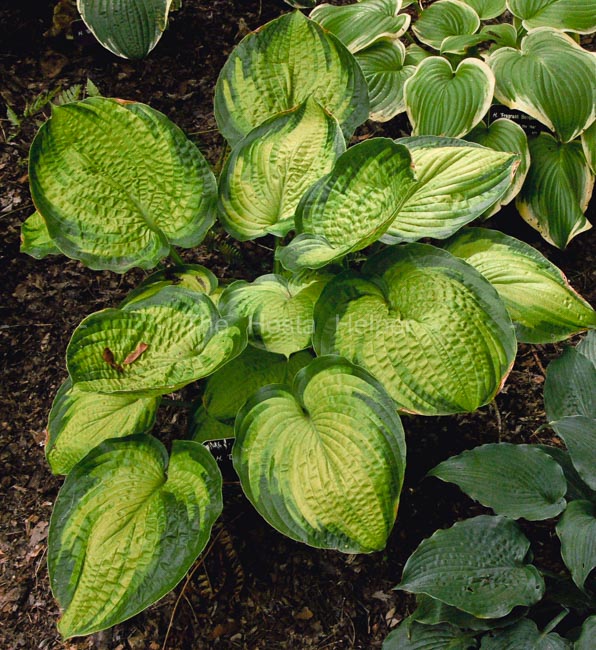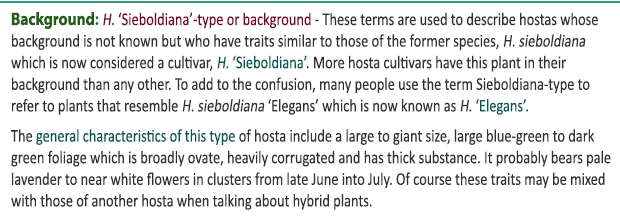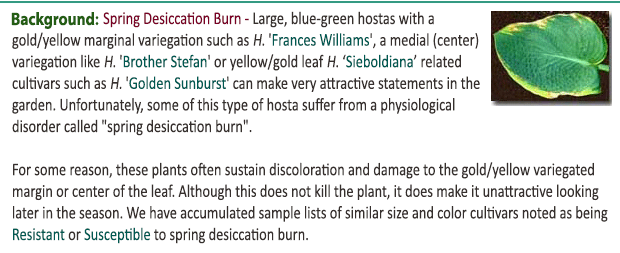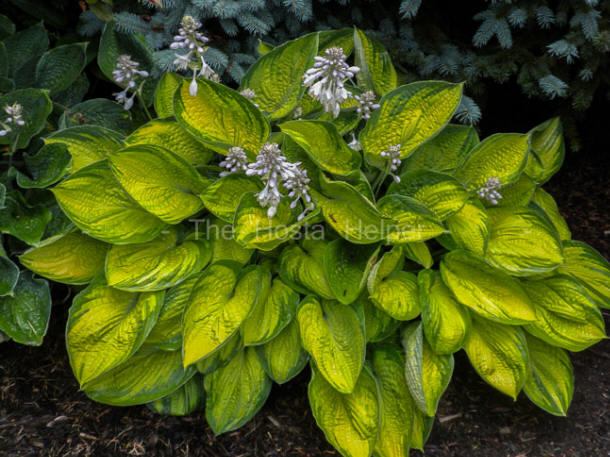|
 This
slow growing sport of H. 'Zounds' was
named for the hosta hybridizer by the same name,
Dr. Dick Ward of Ohio. It was registered by
Handy Hatfield of Ohio in 1991. The large size (24 inches high by 50 inches wide) plant has broadly ovate, heavily corrugated
foliage that is also wavy and cupped. Very pale lavender flowers
bloom from late June into July. This
slow growing sport of H. 'Zounds' was
named for the hosta hybridizer by the same name,
Dr. Dick Ward of Ohio. It was registered by
Handy Hatfield of Ohio in 1991. The large size (24 inches high by 50 inches wide) plant has broadly ovate, heavily corrugated
foliage that is also wavy and cupped. Very pale lavender flowers
bloom from late June into July.
 According to
The Hostapedia by Mark Zilis (2009), "This is considered to be the best gold-centered
H. 'Sieboldiana'-type by many hosta collectors. Unlike the
many sports of 'Elegans' and 'Frances
Williams', it does not develop
spring desiccation burn and
makes a magnificent specimen in the shaded garden. It honors a
person who has made
tremendous contributions to
The American Hosta Society over the last twenty-five or so years." According to
The Hostapedia by Mark Zilis (2009), "This is considered to be the best gold-centered
H. 'Sieboldiana'-type by many hosta collectors. Unlike the
many sports of 'Elegans' and 'Frances
Williams', it does not develop
spring desiccation burn and
makes a magnificent specimen in the shaded garden. It honors a
person who has made
tremendous contributions to
The American Hosta Society over the last twenty-five or so years."
 From the
Field Guide to Hostas by Mark Zilis (2014), "...introduced to the nursery trade in 1992 at $200 per
plant..."A great plant honoring a great man" sums up this
plant...forms an abundance of seed pods, but surprisingly no
progeny have been registered..." From the
Field Guide to Hostas by Mark Zilis (2014), "...introduced to the nursery trade in 1992 at $200 per
plant..."A great plant honoring a great man" sums up this
plant...forms an abundance of seed pods, but surprisingly no
progeny have been registered..."
The New Encyclopedia of Hostas by
Diana
Grenfell (2009) states: "Slow to establish but well worth the
wait...Becomes a brassy yellow if exposed to full sunlight."

 An article by Warren I. Pollock in
The
Hosta Journal (1995 Vol. 26 No. 2) states that, "H. 'Dick Ward' is a handsome new cultivar, a sport of gold-leaved 'Zounds' with a
wide green border. It was introduced and registered by Handy Hatfield...named
for the well-known hosta collector,
Dr. Richard Ward of Columbus, Ohio...H.
'Dick Ward'...currently selling for $150 for nice-sized divisions." An article by Warren I. Pollock in
The
Hosta Journal (1995 Vol. 26 No. 2) states that, "H. 'Dick Ward' is a handsome new cultivar, a sport of gold-leaved 'Zounds' with a
wide green border. It was introduced and registered by Handy Hatfield...named
for the well-known hosta collector,
Dr. Richard Ward of Columbus, Ohio...H.
'Dick Ward'...currently selling for $150 for nice-sized divisions."
An article by Warren I. Pollock in
The
Hosta Journal (1997 Vol. 28 No. 1) states that, "...'Dick Ward' is an expensive hosta, a prize collector's item. It is division
propagated, that is, divisions are separated (cut) from plants growing either in
the ground or in a container...'Dick Ward' is in very limited supply."
| |
|
 An article by
Warren I. Pollack in
The
Hosta Journal (2020 Vol. 51 No. 1) titled
Doppelgänger Hostas: Fancy Name for
Look-alike Hostas, included a long list of hostas
which various hostaphiles, published articles or other sources have
indicated "look" the same. Some of these are, in fact, the same
plant with two or more different names. Others are hostas that vary
in some minor trait which is not immediately discernable to the
casual observer such as seasonal color variations, bloom traits, ploidy, etc. So, as Warren mentions, hostaphiles may differ as to the
plants listed but then, their opinions are based on visual observations and interpretations. An article by
Warren I. Pollack in
The
Hosta Journal (2020 Vol. 51 No. 1) titled
Doppelgänger Hostas: Fancy Name for
Look-alike Hostas, included a long list of hostas
which various hostaphiles, published articles or other sources have
indicated "look" the same. Some of these are, in fact, the same
plant with two or more different names. Others are hostas that vary
in some minor trait which is not immediately discernable to the
casual observer such as seasonal color variations, bloom traits, ploidy, etc. So, as Warren mentions, hostaphiles may differ as to the
plants listed but then, their opinions are based on visual observations and interpretations. |
| |


H. 'Paradigm' appeared on two lists in the article.
According to my last algebra class, if A=B and B=C, then A=C so it
would seem that all hostas on the two lists would qualify as
look-alikes.
List #1 - H.
'Brother
Stefan' and
H. 'Paradigm'
List #2 - H.
'Darwin's
Standard', H. 'Dick
Ward', H. 'Goldbrook
Gayle' and
H. 'Paradigm'
|
|
 |
 |
|
|
"Word of
this magnificent hosta filtered east
last year, so when it was offered in
1992, I couldn't resist. My clump is not
as large as the one we all saw in
Dick Ward's garden, but it is
equally grand. The leaves, an
interesting blend of white, yellow and
chartreuse in the center with an
irregular green edge and with green
veins, are heavily corrugated and thick
as cardboard to insure against any
attack by slugs. And it withstands a lot
of sun. A sure future winner. Available
from
Hatfield Gardens for $200.00." |
|








|



